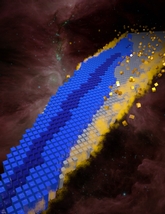Research team maps the nuclear landscape
28 Jun 2012
 An Oak Ridge National Laboratory and University of Tennessee team has used the Department of Energy's Jaguar supercomputer to calculate the number of isotopes allowed by the laws of physics.
An Oak Ridge National Laboratory and University of Tennessee team has used the Department of Energy's Jaguar supercomputer to calculate the number of isotopes allowed by the laws of physics.
The team, led by Witek Nazarewicz, used a quantum approach known as density functional theory, applying it independently to six leading models of the nuclear interaction to determine that there are about 7,000 possible combinations of protons and neutrons allowed in bound nuclei with up to 120 protons (a hypothetical element called "unbinilium"). The team's results are presented in the 28 June issue of the journal Nature.
Most of these nuclei have not been observed experimentally.
"They are bound, meaning they do not spit out protons or neutrons," Nazarewicz explained. "But they are radioactive - they are short-lived, because there are other processes, such as beta decay, that can give rise to transmutations."
Of the total, about 3,000 have been seen in nature or produced in nuclear physics laboratories. The others are created in massive stars or in violent stellar explosions.
The computations allowed the team to identify the nuclear drip lines that mark the borders of nuclear existence. For each number of protons in a nucleus, there is a limit to how many neutrons are allowed.













.jpg)






.jpg)









